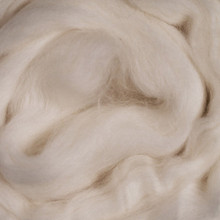 Loading... Please wait...
Loading... Please wait...Categories
New Products
-
$6.50

-
$5.95

-
$60.00

-
$35.95

-
$17.95

- Home
- Fibres
- Sliver - Wool
- Cheviot Top, Natural - White
Product Description
Cheviot are a breed of sheep that originated in the Cheviot Hills on the border of England and Scotland. They are known for their hardiness and ability to thrive in harsh conditions, and are a popular choice for hill farming. Cheviot sheep have a white face and legs, and their fleece is typically white or light gray. Their wool is strong and durable, with a high crimp count that gives it a springy and elastic texture. Cheviot fleece is also known for its good insulating properties, which make it suitable for use in warm clothing and blankets. Their wool is bright white with good luster, which gives it a nice sheen. Easy to spin, beautiful to dye, and fantastic for needle- and wet- felting!
27-33μ thick; 100-140mm staple length
Our wool comes from non-mulesed hogget (15-18 month old) sheep.
This product is a “Top” sliver. All sliver may contain some vegetable matter.
Over the years we've found there are regional differences in the use of terms like "sliver", "roving" or "top" and we tend to use the label provided by the supplier (which may not exactly match what a different supplier may label a similar fibre). Often in modern times these terms are used interchangeably, but historically they've had different meanings.
The way we (Birkeland Bros) use the terms, "sliver" would be the 'ropey' gathering of fibre coming off a carding machine.
If a slight twist is introduced to the sliver to give it strength, it is frequently referred to as a "roving" and tends to be finer than a sliver; for example, a “pencil roving” is never more than a pencil-width in thickness. Some mills might also sell one-ply yarns (like Buffalo yarn) as a roving, since without plying that slight twist is what keeps it from pulling apart easily.
If sliver is put through a pin-draft assembly for additional straightening and removal of short fibres, we refer to it as a "Top" sliver. These tend to be more expensive than a regular sliver because of the extra processing, and tends to be less fluffy than a top. Dyed sliver is almost invariably a "top" sliver: why bother dyeing something that isn't a top?!
100g of sliver is typically sufficient to wet felt a pair of slippers/2-3 dryer balls, or spin and knit a pair of socks; 5-7 lbs of sliver is typically sufficient to knit or crochet a "Giganto" style blanket, depending on the complexity and tightness of your pattern (cabling requires more sliver to accomplish).
Batts will typically measure 24 inches by 40 inches (61 cm by 102 cm) rolled out, with the thickness varying by weight selected. Batts can be easily separated into layers depending on need. Due to larger dimensions/volume, shipping costs will be higher for batts. Shipping costs for batt quantities greater than 3 lbs (1400g) may be calculated very high but we will always do our best to package efficiently and will refund any postal savings.

Product Reviews
-
Great for a beginner

Posted by Unknown on 26th Jan 2021
Wish I'd started spinnning with this wool! It drafts beautifully and it was easy to get a nice, fine, even single, even with my minimal experience. Reasonably priced. I don't remember encountering any vegetable matter. There's a fairly strong sheep smell, but I consider that a positive. :)






